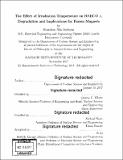The effect of irradiation temperature on REBCO Jc degradation and implications for fusion magnets
Author(s)
Sorbom, Brandon Nils
DownloadFull printable version (32.05Mb)
Other Contributors
Massachusetts Institute of Technology. Department of Nuclear Science and Engineering.
Advisor
Dennis G. Whyte.
Terms of use
Metadata
Show full item recordAbstract
Recent advances in high temperature superconductors (HTS) have opened up a new parameter space for the design of tokamak fusion pilot plants. While previously the maximum on-axis field in a superconducting tokamak was limited to ~6 T, HTS allows tokamaks to be designed with much higher on-axis fields, leading to smaller reactor designs. For these designs, it is critical to determine the lifetime of modern HTS technology in an environment relevant to compact, high-field fusion reactors as well as develop strategies to mitigate this damage. While some studies have been undertaken to assess the lifetime of coated conductors in a fast neutron environment, facilities do not exist to perform cryogenic neutron irradiations at the present. In addition, reactor studies are costly and activate the samples, requiring long cooldown times and specialized analysis facilities to handle radioactive material. In order to complement reactor irradiation studies of HTS and determine whether elevated temperature irradiation has an effect on Jc degradation, REBCO coated conductors were irradiated with a 1.2 MeV proton beam at 80 K, 323 K, and 423 K. Proton irradiation at cryogenic temperatures was found to substantially reduce the amount of Jc degradation in the REBCO samples irradiated to high fluences, a result of great importance to superconducting REBCO magnets in fusion applications where the radiation will occur at T < 80 K. An analysis of temperature, field, and angle dependencies of Jc was performed to investigate the microstructural mechanisms behind the Jc degradation at different temperatures. The key mechanism driving the differences in Jc degradation was found to be radiation-enhanced diffusion at higher temperatures, leading to grain boundary widening between superconducting crystals which in turn blocked supercurrent transport through the conductor. Molecular dynamics simulations suggest that the same mechanism (enhanced diffusion to grain boundaries) also applies to neutron irradiations. This motivates a re-evaluation of previous REBCO neutron irradiation studies at temperatures between 323 K and 383 K, specifically with regards to predictions about REBCO lifetimes in a fusion environment. The work in this thesis suggests that at cryogenic temperatures, the Jc degradation observed in these studies could be substantially less than previously reported.
Description
Thesis: Ph. D., Massachusetts Institute of Technology, Department of Nuclear Science and Engineering, 2017. Cataloged from PDF version of thesis. Includes bibliographical references (pages 143-154).
Date issued
2017Department
Massachusetts Institute of Technology. Department of Nuclear Science and EngineeringPublisher
Massachusetts Institute of Technology
Keywords
Nuclear Science and Engineering.